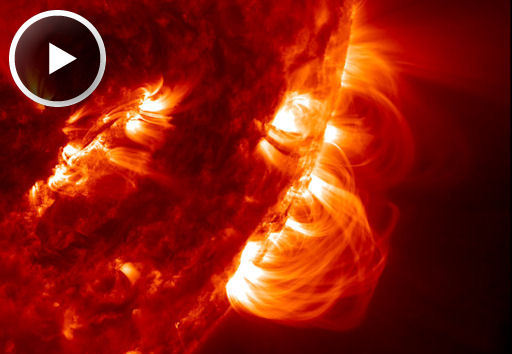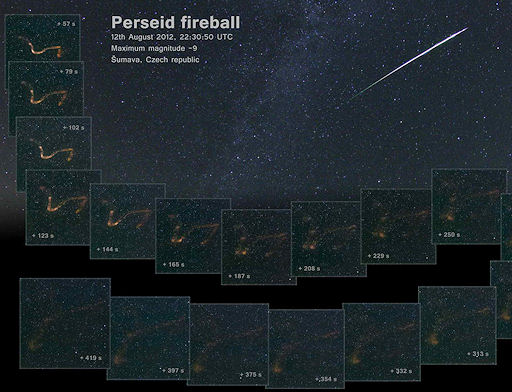Hang the Transit of Venus on your wall! Hubble-quality images from NASA's Solar Dynamics Observatory are now available as metallic posters in the Space Weather Store. | | |
SLIGHT CHANCE OF STORMS: NOAA forecasters estimate a 15% chance of polar geomagnetic storms on August 17th in response to the possible impact of a minor CME. Arctic and Antarctic sky watchers should be alert for auroras. Storm alerts: text, phone.
SOLAR SLINKY: Solar activity is low this week. Nevertheless, NASA's Solar Dynamics Observatory spotted something interesting happening on the sun's southwestern limb. Click to view the "solar slinky" in action:

The loops in the movie are made of magnetism, glowing red-hot because they are filled with 80,000 K solar plasma. They move with slinky-action as they are buffeted by winds in the sun's atmosphere and jostled by minor explosions on the stellar surface below. Of course they are much bigger than a terrestrial slinky. The entire Earth could fit through any of the loops with room to spare.
Realtime Space Weather Photo Gallery
METEOR SMOKE: Researchers using NASA's AIM spacecraft have recently discovered that meteor smoke is a key ingredient of Earth's mysterious noctilucent clouds. "Meteor smoke" is the fine ashen debris left over when a meteoroid burns up in the atmosphere. On August 12th, during the peak of the Perseid meteor shower, Petr Horálek photographed a dense plume of the material twisting and turning over Sumava, Czech republic:

"The fireball that produced this smoke was magnitude -9, [almost as bright as a quarter moon]," says Horálek. "This could be the brightest fireball of the 2012 Perseids." The smokey trail was visible for more than five minutes before it finally dispersed.
If the AIM science team is correct, this smoke will drift through the upper reaches of Earth's atmosphere more than 80 km above the planet's surface. Up there, rare molecules of water will cling to the meteoritic particles, slowly gathering to form tiny crystals of ice until--voilà! A noctilucent cloud is born.
For more whiffs of meteor smoke, click on the link below:
Realtime Perseid Photo Gallery
[NASA video: The 2012 Perseid Meteor Shower]
Realtime Noctilucent Cloud Photo Gallery
[previous years: 2003, 2004, 2005, 2006, 2007, 2008, 2009, 2011]
Potentially Hazardous Asteroids (
PHAs) are space rocks larger than approximately 100m that can come closer to Earth than 0.05 AU. None of the known PHAs is on a collision course with our planet, although astronomers are finding
new ones all the time.
On August 16, 2012 there were 1325 potentially hazardous asteroids.
Notes: LD means "Lunar Distance." 1 LD = 384,401 km, the distance between Earth and the Moon. 1 LD also equals 0.00256 AU. MAG is the visual magnitude of the asteroid on the date of closest approach. | | The official U.S. government space weather bureau |
| | The first place to look for information about sundogs, pillars, rainbows and related phenomena. |
| | Researchers call it a "Hubble for the sun." SDO is the most advanced solar observatory ever. |
| | 3D views of the sun from NASA's Solar and Terrestrial Relations Observatory |
| | Realtime and archival images of the Sun from SOHO. |
| | from the NOAA Space Environment Center |
| | the underlying science of space weather |

